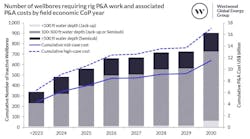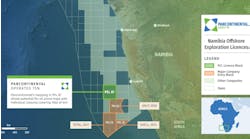Ophir maturing drilling prospects offshore Myanmar, Equatorial Guinea
Offshore staff
LONDON – Seadrill’sWest Saturn drillship will start drilling the Ayame-1X well on block CI-5113 offshore Côte d’Ivoire during 2Q.
OperatorOphir Energy signed a PSC for the block last year and estimates potential recoverable resources in the stratigraphic Ayame prospect at 234 MMbbl, with a 23% geological chance of success.
The well, likely to cost $30 million, will test an extension of a proven petroleum system in the adjacent block, the main risk being trap effectiveness.
Elsewhere last year, Ophir also entered the DW-2A license off Malaysia and will take a drill-or-drop decision by mid-year.
Its third new license wasdeepwater block 5 offshore Mexico, as part of the Murphy-operated consortium with Petronas and Sierra Oil & Gas. Here drilling is unlikely before 2019.
Off Myanmar, Ophir has matured a prospect inventory over its offshore acreage to drill-ready status. The play appears to comprise sands in low-relief channel systems. The company is looking to farm down some of its interest to a partner as a pre-requisite to drilling.
In Equatorial Guinea, the southwest portion of Ophir’s offshore block R contains a potential extension of an oil play in the neighboring block over which the operator acquired 3D seismic survey last year that extended into block R.
The data has been processed and geoscience teams for both blocks are assessing prospectivity ahead of a decision on whether to drill a well.
During 4Q 2016, Ophir completed the Trepang 3D seismic survey on the West Papua IV and Aru licenses offshore Indonesia, and also finished reprocessing existing seismic data over both licenses. This has helped the company convert numerous leads to prospects.
Off Gabon, the company has extended its Nkouere and Nkawa licenses and is using the Olumi Rouge 3D seismic data to mature a new outboard play, which it believes has multi-billion barrel potential. Here too it is seeking to bring in a partner a second-phase of exploration.
In blocks 1 and 4 offshoreTanzania, Ophir is a partner to Shell which became operator last year after buying BG Group. Shell has since conducted a review of the development scope for the various deepwater gas fields and the cost.
Since the elections in Tanzania in late 2015, the new government has taken a more pro-active, hands-on approach to delivering the project, Ophir adds, and has established an integrated negotiating team with representatives from all the key ministries to deliver a project agreement for the onshore LNG plant.
Once this is agreed to, there should be a clear legal framework under which the development can move forward.
Late last year the partners completed drilling the final exploration commitment wells on the blocks, and the Minister of Energy has since awarded a three-and-a-half extension of block 1 to allow sufficient time to complete pre-front-end engineering and design (pre-FEED) and FEED ahead of investment approval. An extension for block 4 is likely later this year.
In the Gulf of Thailand, Ophir’sBualuang oil field has been averaging 8,700 b/d.
Last year the main focus was on completing a $21-million water debottlenecking project that lifted water handling capability by 50%, leading to an increase in production.
An ocean bottom node 3D seismic survey acquired in 2015 to image under the platform has been processed and interpreted and will assist future planning for the field.
This year Ophir plans two infill development wells with the aim of increasing production by around 1,400 b/d. The program will likely cost around $12 million. Another well will be drilled targeting fresh prospective resources in the Bualuang field.
In addition, work is nearing completion on technical and commercial analysis to expand production capacity via installation of a simple, low-cost platform. The additional well slots would allow targeting of locations to convert prospective and contingent resources to reserves.
An investment decision should follow during 2Q.
03/13/2017


